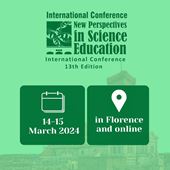Transparent Inorganic Metal Oxide Solar Cells in Chemistry Class
Edwin Bogdan, Georg-August-University Goettingen (Germany)
Jan Fleischer, Georg-August-Universität Göttingen (Germany)
Thomas Waitz, Georg-August-University Göttingen (Germany)
Abstract
Due to the increasing challenges related to climate crisis and energy supply, the development of renewable energy sources is a major field of research and important for sustainable developments. In this context, solar cells play an important role and are already widely applied based on silicon. Nevertheless, silicon solar cells exhibit disadvantages such as a high energy demand during production and the requirement of highly pure raw material.[1] For these reasons, the working principle of silicon solar cells can only be discussed theoretically in chemistry classes, but their production under school conditions is not possible. Because of the disadvantages related to silicon solar cells, alternative solar cells like Grätzel cells[2] and perovskite solar cells[3] have already been subject in scientific research and can - in contrast to silicon cells - be easily built within a school lesson.[4-5] Furthermore, pure inorganic solar cells based on combined thin films of p- and n-semiconducting oxides of titanium and nickel have come into interest of researchers.[6] Being optically transparent and durable, their future integration as a photovoltaic active layer in windows is discussed, deposited by physical techniques like sputtering. For educational purposes, we developed a process to replace sputtering by facile sol-gel-syntheses which can be easily implemented in schools: After preparing a particle dispersion, thin films of two semiconducting metal oxides creating a heterojunction are applied on conductively coated glasses (FTO) with a self-built spin-coater assembled using low-cost components. In our contribution, we present experiments as well as teaching and learning materials covering topics from chemistry (sol-gel-synthesis) and physics (semiconductors) for upper secondary classes.
Keywords
solar cells, sol-gel-chemistry, renewable energies, education for sustainable development, curricular innovations
References
[1] Klugmann-Radziemska, E. (2023). Environmental Assessment of Solar Cell Materials. Ecological Chemistry and Engineering S, 30(1), 23–35. https://doi.org/ 10.2478/eces-2023-0002
[2] O'Regan, B., & Grätzel, M. (1991). A low-cost, high-efficiency solar cell based on dye-sensitized colloidal TiO2 films. Nature, 353(6346), 737–740.
https://doi.org/10.1038/353737a0
[3] Kim, J. Y., Lee, J.‑W., Jung, H. S., Shin, H., & Park, N.‑G. (2020). High-Efficiency Perovskite Solar Cells. Chemical Reviews, 120(15), 7867–7918. https://doi.org/10.1021/acs.chemrev.0c00107
[4] Siemsen, F., Bunk, A., Fischer, K., Korneck, F., Engel, H., & Roux, D. (1998). Solar energy from spinach and toothpaste: Fabrication of a solar cell in schools. European Journal of Physics, 19(1), 51–58. https://doi.org/10.1088/0143-0807/19/1/008
[5] Cherrette, V. L., Hutcherson, C. J., Barnett, J. L., & So, M. C. (2018). Fabrication and Characterization of Perovskite Solar Cells: An Integrated Laboratory Experience. Journal of Chemical Education, 95(4), 631–635. https://doi.org/10.1021/acs.jchemed.7b00299
[6] Nguyen, T. T., Patel, M., & Kim, J. (2020). All-inorganic metal oxide transparent solar cells. Solar Energy Materials and Solar Cells, 217, 110708. https://doi.org/10.1016/j.solmat.2020.110708
 New Perspectives in Science Education
New Perspectives in Science Education





























